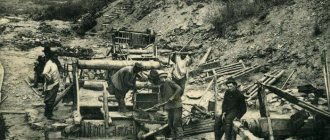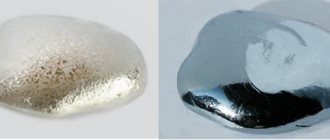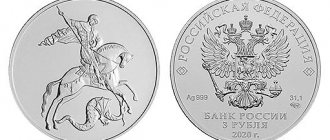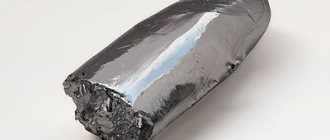Now it is difficult to say which nugget was the largest in history. The fact is that there is not information about all the pieces found, because they were often melted down in the past, and data about them was not preserved. Information about some nuggets has now reached us only in the form of legends and myths, while others have been preserved and have documentary evidence. What was the largest gold nugget in the world?
Australia's largest nugget
In order to figure out which nugget was the largest in the world, you need to understand what is meant by this word. The fact is that gold in nuggets is not always pure; it can have inclusions of silver, quartz and other metals. Nevertheless, such gold will be called native.
Nuggets are mined both in placer deposits and in mines. And geographically the largest of them were discovered in Australia. It turns out that this continent is extremely rich in precious metal.
Mephistopheles
“Mephistopheles” is an unusual nugget weighing 20.2 grams, stored in the collection of the Diamond State Fund of Russia. It was found by gold miners in one of the mines in Chukotka in mid-1944. The piece of gold got its name due to its unusual shape, reminiscent of the profile of the literary character in the book “The Tale of Doctor Faustus,” Mephistopheles. It was initially assumed that the nugget had undergone pre-treatment before entering the museum, but long-term research showed that its shape was natural and not artificial.
Historical data
Surface pebbles rarely reached significant weight. They usually weighed a little over one hundred grams. Truly significant finds were discovered by man deep underground. Quite often, such stones, which were found at placer deposits, could weigh several kilograms.
The historical fate of large gold nuggets in many ways resembles the fate of diamonds. They were also given big names and titles, and most of these nuggets are in state museums and private collections. Throughout history, seekers and diggers have found about 10 thousand gold stones. Moreover, each weighs at least 10 kilograms. If you calculate the total weight, you get a fairly significant figure.
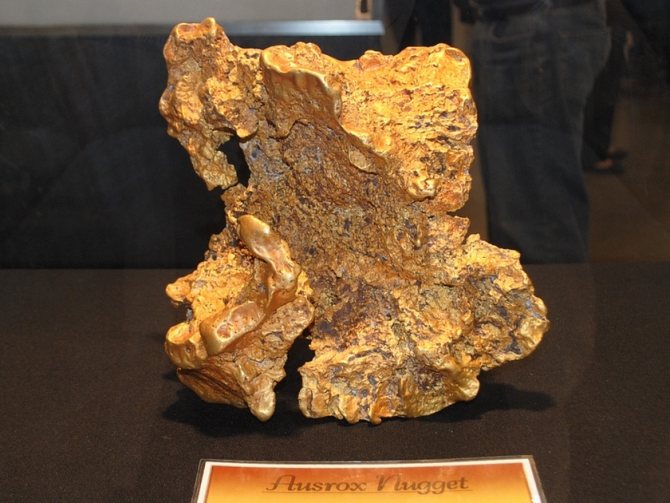
A large number of these pieces were melted and used for various purposes:
- To create jewelry;
- For the manufacture of equipment;
- For other industrial purposes.
But the last significant fossils, which were found over the past decades, can be seen in museums as exhibits. The first largest nugget of gold was mentioned in the records of Arab chroniclers. It was discovered in the territory of modern Afghanistan. If you believe the ancient descriptions found in the chronicles, then its parameters were equal to two cubits. If anyone doesn’t know, the cubit is an ancient unit of measurement, which is about forty centimeters.
Scientists carried out mathematical calculations and determined that, in accordance with modern units of measurement, the mass of this gold stone can be from 2 to 2.5 tons. If the mentions of the chroniclers are not a simple myth or legend, then this nugget can rightfully be considered the largest in the whole world.
One book, which tells about the long history of this mineral, talks about gold nuggets that were found in Brazil. According to preliminary data, their mass was about 200 kilograms. But since experts have not confirmed this statement, one cannot be completely sure that it is true.
It is known for sure that until the 11th century history does not know such significant finds.
Today, scientists consider the largest nugget to be a piece of noble metal called the Holtermann Plate.
It was found on a huge pile of quartz, which weighed about 250 kilograms. The mass of pure gold was 93 kilograms. This nugget was found in Australia in 1872.
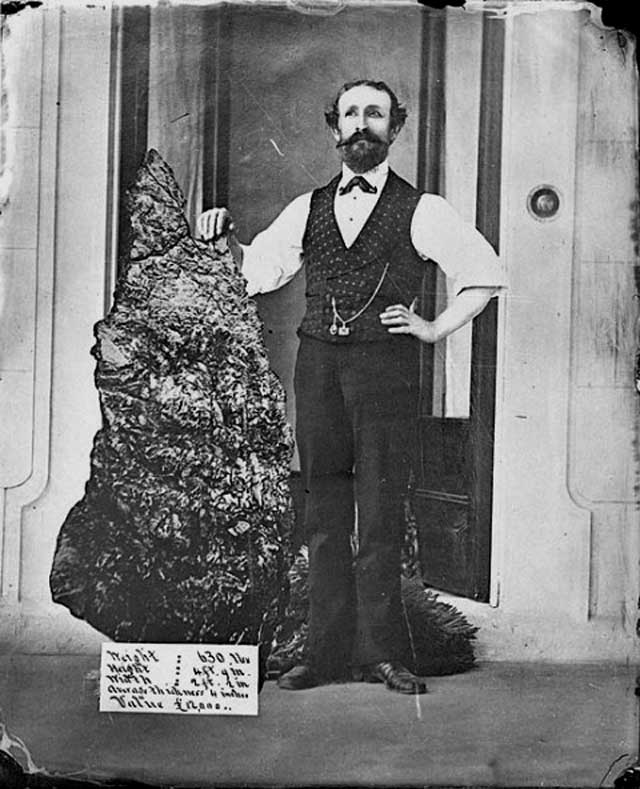
"Holterman Plate"
Distribution by country
Australia is the leader in the number of such successful excavations. In 1869, a nugget named the Desired Stranger was presented to the people, who was found right on the road. His weight was 70 kilograms. In the same state there is a gold stone whose mass exceeds 54 kilograms. This is a find called the Shiny Barkley.
"Welcome Stranger"
A large number of gold deposits are located in Japan, the land of the rising sun. Numerous large objects were not found there, but nature decreed that in 1901 a nugget named Japanese was found. The largest gold nugget, which is the only one in Japan, weighs 71 kilograms.
America also boasts a large amount of gold reserves. The most famous is the precious stone, which was not discovered in a mine. He was found in a grave. An American was digging a grave for his dead friend. While digging, the American encountered a stone, which today is called Oliver Martin. The owner of this exhibit quite often put it on public display in the largest cities of America.
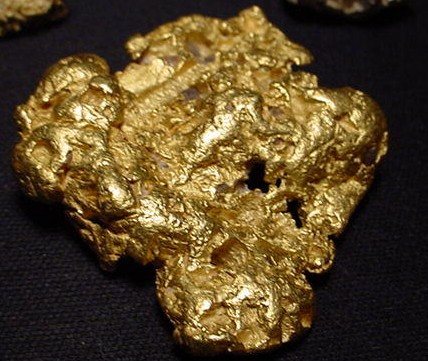
"Oliver Martin"
Many noble reserves are located in the vast expanses of the Russian Federation. Of course, the items found in Russia cannot compare with the huge stones that are found in Australia, but even today you can find items there that can weigh up to about 30 kilograms. Such detections are evidenced by numerous videos and photo reports.
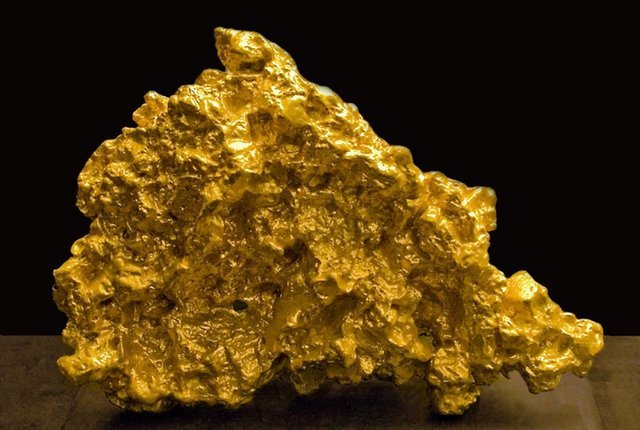
"Big Triangle".
The first large nugget, which is by far the most significant in Russia, was excavated in the Urals in 1842. It was called the Great Triangle because of its great resemblance to this geometric figure. His weight was 36 kilograms. This triangle is also known throughout the world because it is the largest piece of gold to date. All other items that were located on the territory of other states were melted down or processed.
Then its value was 28,146 rubles. The cost of the "Big Triangle" today is many times higher.
The world's richest collection of nuggets is located in the Diamond Fund of the Russian Federation.
In 1967, 100 nuggets with a total weight of 200 kilograms were presented at the Foundation’s international exhibition. Among them, the most beautiful and unique were chosen: “Mephistopheles” (20 g), “Horse Head” (14 kg), “Camel” (9.3 kg), “Hare Ears” (3.34 kg).
The “Mephistopheles” nugget is interesting in its shape.
Despite its light weight, it arouses the admiration of visitors: it represents the impeccable shape of the Mephistophilus profile.
When it was discovered, prospectors argued: it was a gold product or a natural nugget.
After an analysis of the structure, it was decided that this was still a natural creation, and not the work of man.
“Golden Heart” (20 kg)
Found by Nick Martinex in Alaska, it is also unique, since when it was found it did not look gold at all - it was disguised with a black mineral film, under which it was difficult to guess the precious metal. The Heart of Gold nugget is recognized as the fifth largest nugget found in Alaska in the US gold reserve.
Golden heart
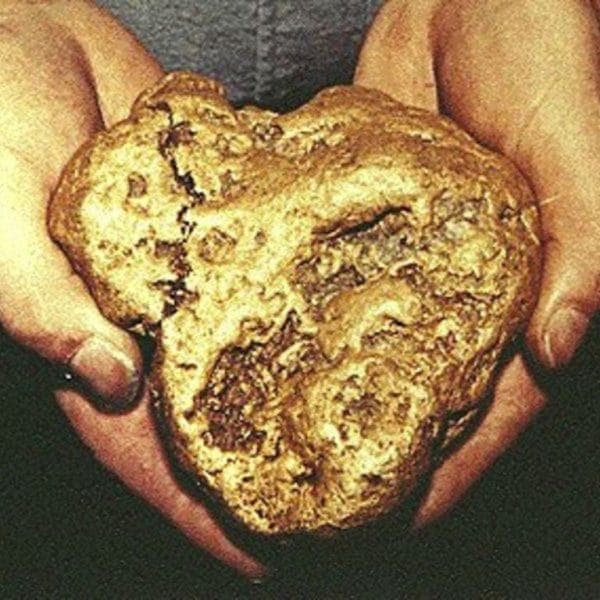
The nugget was found in Alaska by miner Nick Martinex from California. The heart-shaped piece of gold weighs 2.55 kilograms (90 ounces). "Heart of Gold" originally looked like a rock covered in a crust of crystals and minerals. When Martinex accidentally hit it with a pickaxe, the shell split open, revealing some of the gold ore. The nugget was carefully removed from the soil, peeled, and then sold to the American Mint. The man who discovered the "Golden Heart" says he is proud of his find and was very worried that the piece of precious metal would not break when it was cleaned with a chisel.
Since man learned to extract gold from the bowels of the planet, over 200,000 tons of pure precious metal have been extracted. If you melt it down, you will get an equilateral cube the height of an eight-story building.
List of largest specimens
It is officially recognized that the largest native gold was found 145 years ago in Australia by Bernard Halterman. He came to this country in search of a better life and by that time had been developing alluvial deposits for several years.
At first he was plagued by failures, but in 1871 he began working at the Hill End mine. And on October 19, 1872, together with his partner, he discovered an incredible find - a gold slab weighing 235 kilograms, but, as it turned out later, there was only a little more than 80 kilograms of gold, the rest was quartz. The weight of the nugget was documented and it was melted down. All that remains are photographs taken by Holterman. Naturally, the prospector gained money and fame. True, now scientists are of the opinion that it was not a nugget, but a piece of vein: due to the large amount of quartz.
But the largest pure gold nugget is “Welcome Stranger”. It weighed significantly less, only 70 kilograms, but, unlike the previous one, the piece of gold consisted of pure metal.
This find belongs to prospectors John Deason and Richard Outus. And this happened in Australia on February 5, 1869. They were working in the vicinity of the city of Moliagula and accidentally came across a nugget while pulling a cart out of the mud.
Having stumbled upon something hard and hit it with a pickaxe, they decided to dig up the object. It later turned out that it was gold. The find was so large that they could not weigh it completely; they simply did not find such scales. So they sawed it and then melted it down.
Another notable nugget, the Hand of Faith, is famous for being the largest gold nugget found using a metal detector. And its origin is also Australian. Was found in 1980. Kelvin Hillier decided in the spring to try out his new metal detector in the tiny town where he lived. His surprise was great when, instead of a coin or a cork, he found a whole gold nugget weighing 27 kilograms and worth a million dollars.
bunny ears
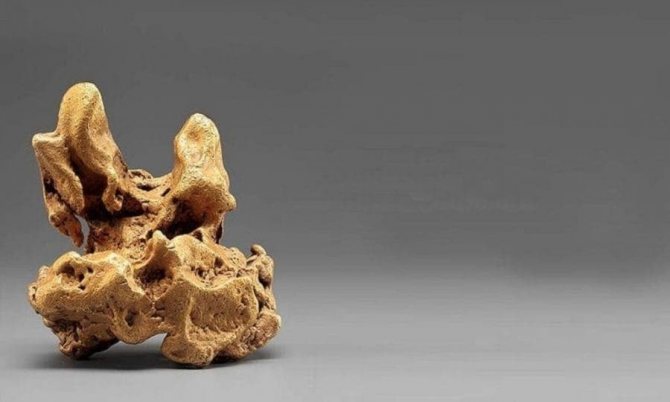
In the Urals, near the small settlement of Leninsk, one of the largest gold mines in Russia, discovered under Alexander I, operated for many years. At the beginning of 1935, when the gold mine was preparing to close, a lonely prospector Pyotr Simonov accidentally discovered a piece of gold in the ground, the weight of which exceeded 3.3 kilograms. But the nugget was considered unique not because of its mass, but because of its shape. It resembled a hare's head with long ears.
According to the laws of that time, such a large piece of gold could not remain the property of Simonov and he had to give it to the state. The nugget was placed in the royal treasury, from where it later ended up in the National Museum of Mineral Resources of Russia. The replica of “Hare Ears” is kept in the local history museum of the Chelyabinsk region.
The fate of nuggets
Historically, the fate of large finds is similar to the fate of large diamonds. They were also given big names, and some of them were preserved in state museums and private collections. Throughout history, about 10 thousand gold stones weighing more than several hundred grams have been found. In total weight this turns out to be quite a significant figure.
These gold nuggets were mostly smelted and used for various purposes. They were used to create jewelry or used them in industry, for example, to make radio components for military equipment. Not counting those that were left, and you can still admire them now.
Nowadays, gold is mined industrially, but it happens that amateurs also find native metal. In 2014, a piece of gold weighing 2.35 kilograms was found in the United States. Now such a relatively small find is estimated at about half a million dollars. In the same year, a nugget was found in the Irkutsk region. It weighed just over 6.5 kilograms and was called the “Devil's Ear.” It was mistakenly taken for a stone and thrown into the dumps, and then found by a worker who was leveling the rock.
You can still find fairly massive native gold. Despite the fact that most of them were excavated in mines, there were also finds in placer deposits. Therefore, if you get a good metal detector and enlist support, then anything is possible. The main thing is not to give up hope. True, a good metal detector will cost a pretty penny, but there is a chance that it can be repaid with the coins, gold jewelry and small pebbles of gold found. The technology for extracting gold from alluvial deposits is not complicated, and there are many of them in Russia, but do not forget that any gold found, by law, will have to be given to the state for next to nothing, leaving it will be illegal.
Camel
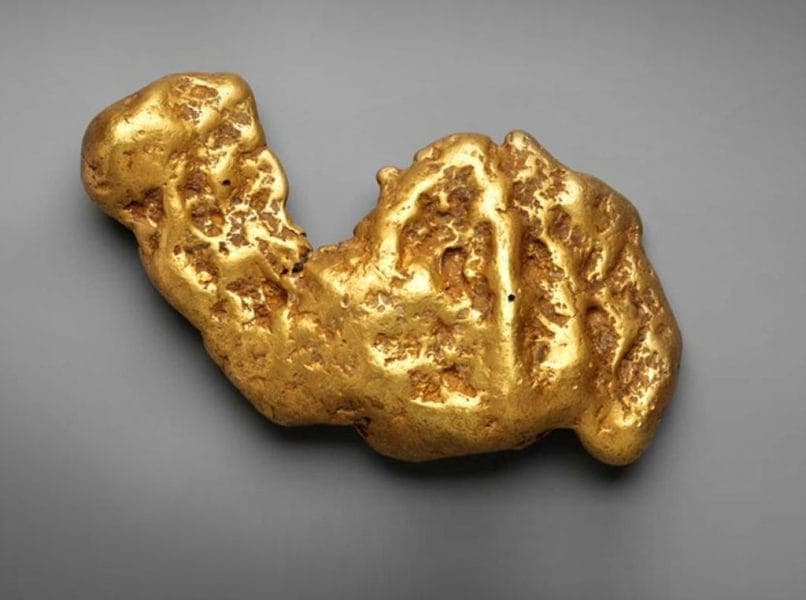
“Camel” is an unusual gold nugget, the shape of which resembles the outline of the body of the animal of the same name. It was found by Russian miners in the depths of a mine in Kolyma in 1947. The weight of the piece of precious metal was 9,300 grams. It was not melted down, but transferred to the collection of the Diamond State Fund, where it became one of the main exhibits. All visitors to the annual exhibition can look at the rare and unique nugget.
Preserved natural wonder
The third largest surviving gold nugget in the world is the Great Triangle. It belongs to the Diamond Fund of Russia. The natural ingot weighs 36 kg. This is a find of 1842 on the Mias River, the territory of the Urals.
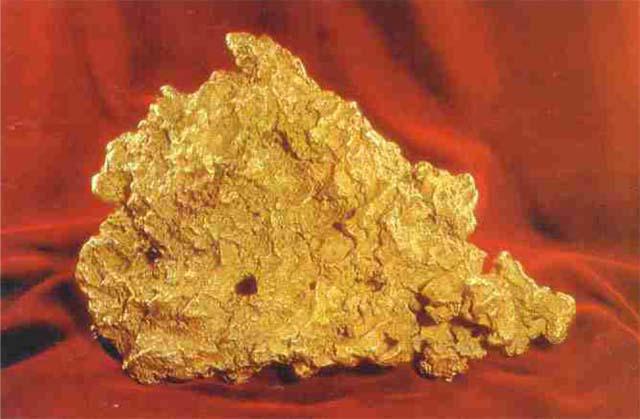
I would like to mention a nugget from the Russian collection - “Mephistopheles”. It never fails to delight viewers with its exact match to the profile of the character of the same name and weighs 20.25 grams.
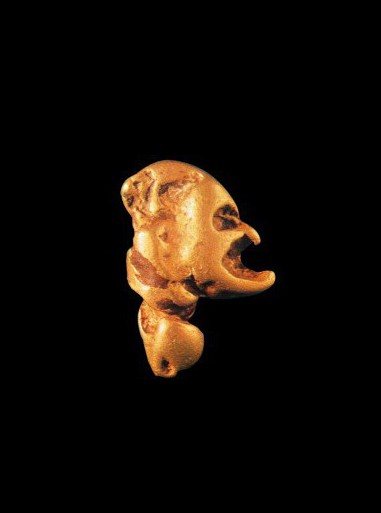
Russia has the largest collection of gold nuggets in the world, the exhibition of which was opened in 1967. It showed the world about 100 nuggets, the total weight of which was more than 100 kg.
Throughout the existence of mankind and the development of civilization, gold has attracted us with its brilliance and magic. It forced knights to do crazy things, desperate ones to go to the ends of the world. Surprises awaited the most stubborn at the end of the journey, and not always the ones they wanted. But faith and hope did not abandon the brave souls.
Horse head
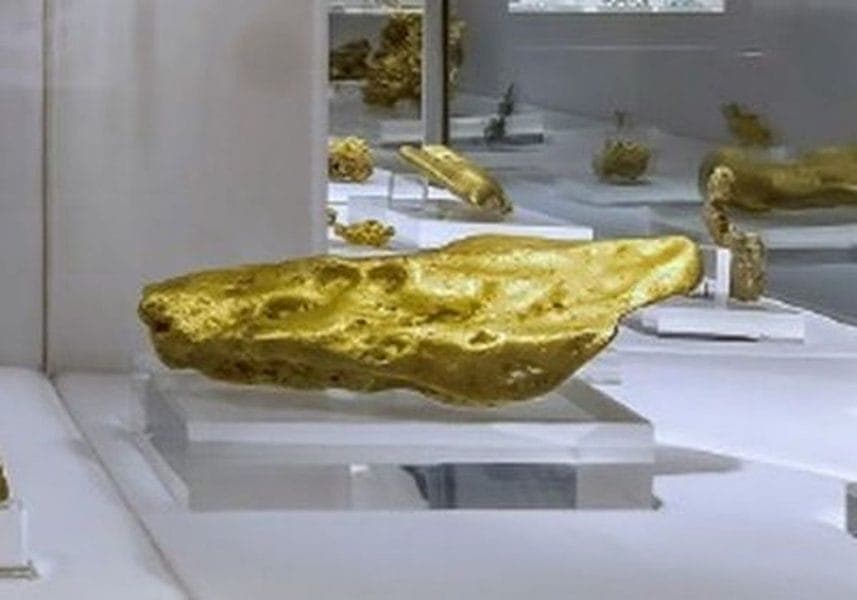
In 1936, a large gold nugget of a strange shape, reminiscent of a horse's head, was found in one of the Ural mines. The elongated piece of precious metal weighed 13,700 grams. It was transferred to the collection of the Diamond State Fund of Russia. It is located next to another uniquely shaped “Dolphin” nugget. This piece of gold was discovered on the banks of the Lena in one of the largest gold deposits, Bodaibo. “Dolphin” is slightly inferior to “Horse Head” in weight. Its weight is 10,040 grams.
XIX-XX century. The end of the “fever” and a new wave
Competition among miners was growing.
Industrialists were nervous, fought for mines and cheap labor, and paid bribes to officials to get permission for new production. The deposits were quickly destroyed - the gold was collected “at the top” and abandoned. Production gradually fell. In the record year of 1847, one province produced 1,305 pounds of gold, and in 1863, the entire Eastern Siberia produced only 714 pounds.
Soon the “fever” ended: everything that could be mined by hand was mined. The owners of the mines simply gave them to contractors, and to those who were lucky, they rented them out. The industry became smaller, and only small mines and miners' artels remained. Geological exploration was completely abandoned. “...There were only two people capable of distinguishing rocks at least in rough terms,”
- writes the book “Gold of Siberia” about the end of the century before last. It became unprofitable to develop mines manually.
Although there was great luck. In 1898, two prospectors, Tarkhan and Belov, quite by accident found the largest nugget in Central Siberia, the “Bull’s Head”,
weighing 31.6 kg!
At the end of the shift, the workers went into the workings to clear the rock. One touched a lying stone with a pick, the other tripped over it - and they saw the trace of the impact flash with yellow light. Never before had such luck fallen into their hands.
They decided to steal the nugget - they hid it behind the support (an arch that is placed so that the excavation does not collapse). With joy, they drank for a week, and during the binge, one blabbed to his wife about the valuable stone. She couldn’t hide the secret either.
The next morning the nugget was seized by the mountain guards. But the co-owner of the mine was incredibly happy with the find. He did not punish the workers and even paid a lot of money - 2 thousand rubles. According to legend, the money was drunk again.
After the end of the “fever”, industrial gold mining began in the region
— large enterprises emerged, based on serious geology and mechanical engineering. The first dredges, which had long been used in America and Australia, were brought to the Yenisei province. A dredge is a floating “excavator” that takes soil from great depths of gold-bearing rivers, washes it, replacing hundreds of miners.
The largest number of dredges in Russia were installed on our Uderey River (the first was at the Californian mine). By 1910, 33 dredges were operating in the province, more than half of all available in the country. By 1917, 18 joint-stock enterprises operated at the mines.
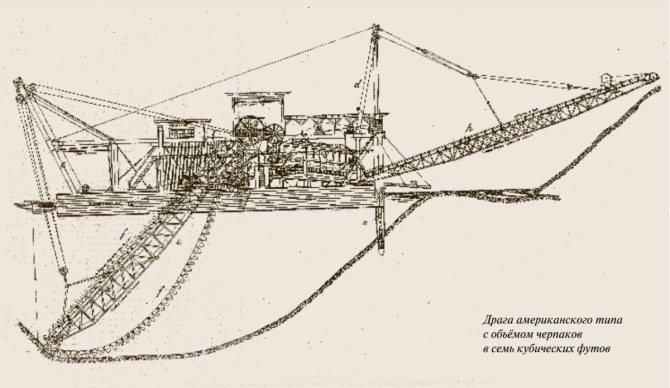
With new technologies, the industry has become profitable again.
In 1916, local industrialists announced plans for the future - to conduct geological exploration throughout the province, to create their own industry bank, which would finance the construction of mines, refineries, roads, and telegraph lines. They wanted to build a railway deep into the taiga, build a bridge across the Yenisei near Yeniseisk, and open a technical institute in Krasnoyarsk. But the revolution got in the way.
Royal gem
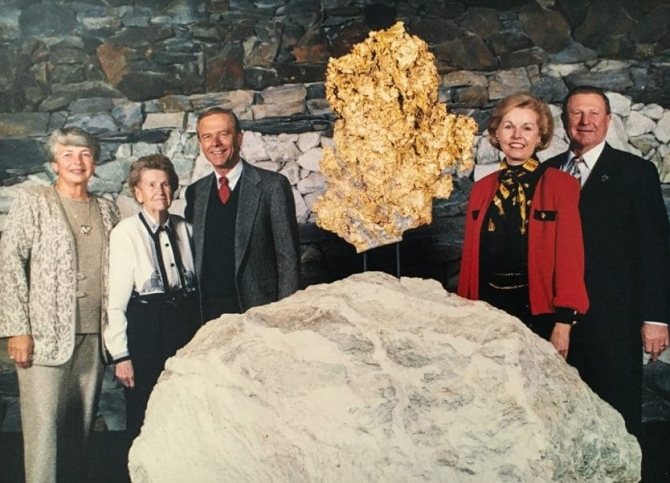
The "Iron Jewel" or "Royal Jewel" nugget is a single crystalline gold. It was discovered in a piece of quartz rock in 1992 at mines owned by the Sonora Mining Company. To avoid damaging the gold ore, the quartz shell was removed using hydrofluoric acid. The mass of the piece of precious metal was 16,400 grams. The nugget was donated to the Ironstone Vineyards Museum, which is located in the center of California. It has become a symbol of the state, which became famous throughout the world for the “gold rush” of the 19th century.
Normandy Nugget
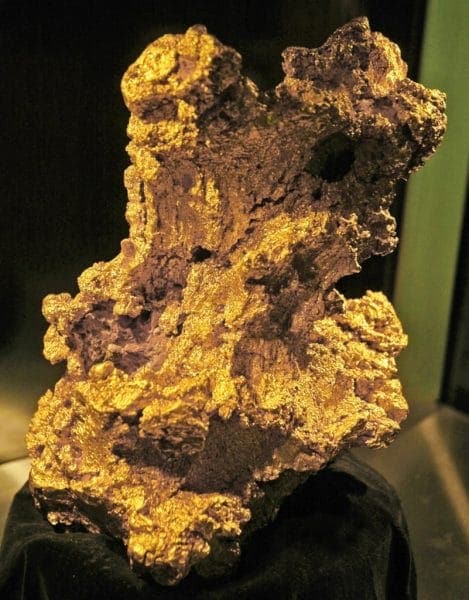
Another name for the nugget is “Solid Normandy”. It was found in 1995 by miners working at a mine near the town of Calgourie (Australia). According to the data recorded in their diaries, the mass of a single piece of gold was 25.5 kilograms. After being melted down, it lost about 20% of its weight. The nugget was sold to the management of Newmont Gold Corporation. The gold bar, obtained after melting down a block of precious metal, is in the private collection of the Perth Mint.
Hand of Faith
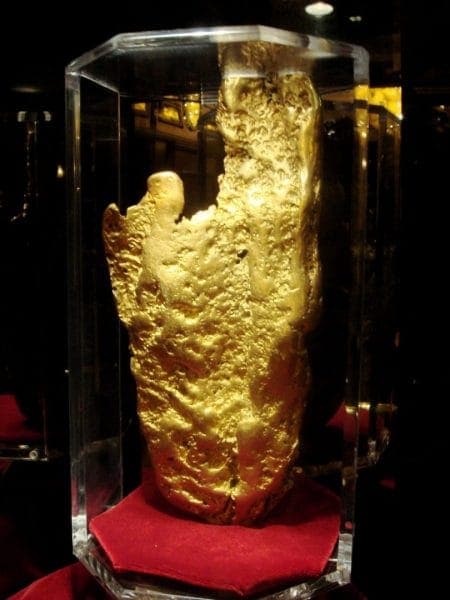
A large piece of gold ore was found in early 1980 in the state of Kingover (Australia) using a metal detector. Its owner was the owner of a private gold mining enterprise, Kevin Hillier. The Hand of Faith weighed 27.6 kilograms and contained 870 ounces of pure gold. The nugget did not stay long in Kevin Hillier's collection. Soon he received an offer to sell it to the director of a famous gambling establishment in Las Vegas. The cost of the transaction remained secret. Today you can see the “Hand of Faith” in the museum located on East Fremont Street in the old Las Vegas area.
In Japan, a very popular show involves pulling a 12-kilogram gold bar through a small hole with your hands. The winner receives it as a reward.
Start: Ore at the fort
Historians claim:
The first metallurgical industry in Russia appeared near Minusinsk 2 thousand years BC. The inhabitants of southern Siberia - the Scythians and Sarmatians - made figurines of animals and birds from silver and gold. Many such figurines were stolen from burial mounds by grave diggers. Archaeologists got a little less: the jewelry is kept in the main museums of the country, for example, it is considered the pearl of the Siberian collection of the Hermitage.
The mining of gold and silver, already as a business idea, captivated the first conquerors of Siberia. In 1626, the Yenisei governor Yakov Khripunov reported on silver placers found by the Cossacks on the lands of the Tungus princes. The Moscow authorities ordered the expedition to be assembled, but “there were many obstacles,” and the first geological exploration in the history of the region had to be cancelled. Khripunov himself was blamed for everything, so he never spoke about gold and silver again, and soon died. But the governor managed to assemble and send another expedition - led by Andrei Dubensky, who founded the Krasnoyarsk fort in 1628.
City's legends:
how Khripunov proposed to build the Krasnoyarsk prison
And already in 1654, gunner Ivashko Obednin accidentally found a “difficult stone” under the prison - gold ore. But in those days, gold mining was an exclusively state matter, and the authorities in Siberia had many other worries. First of all, the treasury was interested in furs because of its incredible profitability. Therefore, the first mines in the Yenisei taiga appeared only after a century and a half.
Big triangle
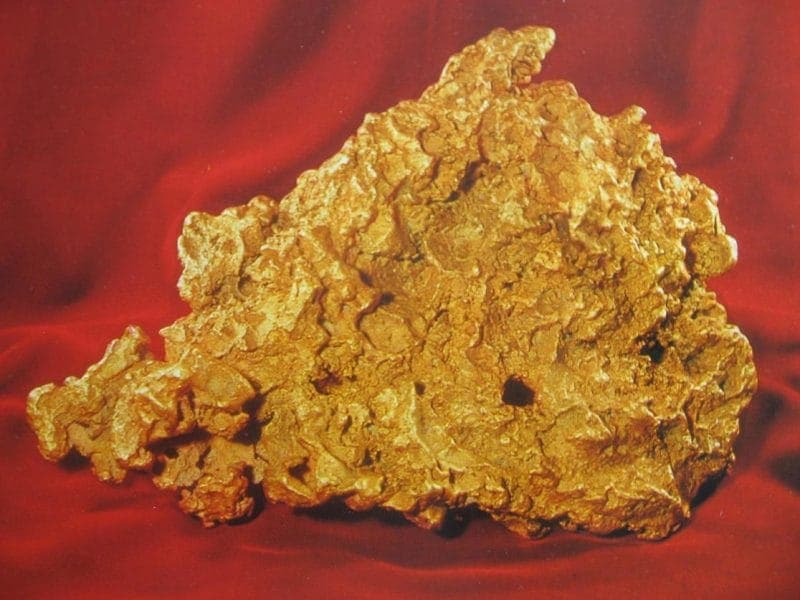
The largest gold nugget found in Russia in 1842. It was dug up by Nikifor Syutkin, an employee of the Ural gold mining company, at a depth of 3.5 meters. The weight of the block of precious metal was 36,200 grams, of which 91% was pure gold. The nugget was named “Big Triangle” because of the shape of the ore piece. From the moment the block is extracted, it is considered the property of the Russian Empire. It was placed in the collection of the Diamond State Fund next to large precious stones and the largest platinum nuggets found in the country.
Nuggets in Russia
Gold nuggets are not uncommon in Russia. The largest nugget discovered here is called the Golden Triangle. It was found in the Southern Urals in 1842 by Nikifor Syutkin, who was only 18 years old at that time. Moreover, the mine in which the young man discovered it was considered depleted.
But nevertheless, finds are still being discovered there. Now the “Golden Triangle”, along with others, is kept in the Russian Diamond Fund. By the way, the find did not bring happiness to the guy; he drank himself to death on the money he earned for it.
Another giant weighing 31 kilograms was found in 1895. Two workers touched a stone in clay with a pick, which turned out to be gold. They decided not to show their find to anyone and hid it, but one of them told his wife and the next day everyone found out. Despite the fact that the workers kept silent about their discovery, they still decided to pay them compensation.
In Soviet times, nuggets weighing more than 20 kilograms were not found. Most often, finds weighed 14 kilograms, and stones weighing 18 and 15 kilograms were also found in the deposits of Yakutia.
What is unique about Russian nuggets is that they were not all melted down, but were preserved in the Diamond Fund, which is now the richest collection in the world. They are periodically shown at exhibitions. For example, in 1967, several nuggets weighing 14, 20 and 3 kilograms were shown in Moscow.
Pepita Kanaa
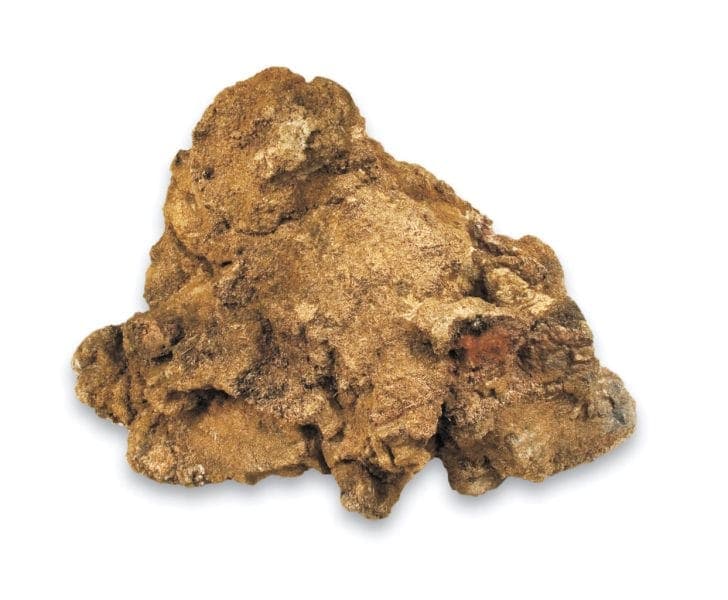
A piece of gold weighing 60.5 kilograms was found in Brazil in 1983 by a miner with many years of experience, Julio Filo. When extracting a nugget from the depths of the Serada-Palada mine, it was accidentally split into two unequal parts. The ore was bought by a coin minting company. A huge coin was smelted from it, which was called Pepita Kanaa. The weight of the product was 52 kilograms. 8.5 kg of impurities were sifted out during the process of melting down a piece of gold. The coin was transferred to the monetary museum of the State Bank of Brazil, where it remains to this day as the main exhibit. Anyone can look at this masterpiece of the mint.
Nugget Henry Share
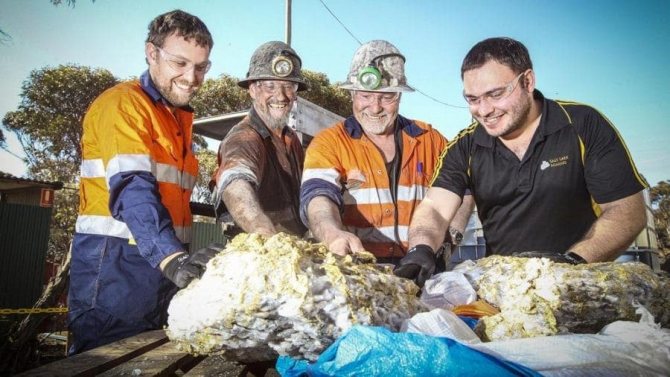
Despite the fact that the “gold rush” came to an end a long time ago, gold miners do not stop digging in the earth in search of precious ore. In 2021, Australian miner Henry Dole decided to start excavations near the town of Kambalda. In September, luck smiled on him. In one of the walls of a nickel mine, he discovered a rich deposit of gold. After the explosion, the floor of the adit was strewn with pieces of precious metal, the largest of which weighed 90 kilograms. Another nugget had a mass of 65,200 grams. After melting it down, a 45-kilogram ingot was obtained. It is unknown where the nuggets found by Dole went, but in the place where the lone miner was excavating, a mine was built for the extraction of minerals.
What is a gold nugget?
Gold nuggets are large pieces of native metals. Experts have not yet come to a consensus on which piece of gold should be called a nugget.
Some professionals call for ingots weighing more than 1 kg to be called nuggets, while others are inclined to think that a piece measuring about 4 mm rightfully deserves such a name if nature has endowed it with a unique shape and bright shine.
It was the nuggets found that became the beginning of people’s acquaintance with precious metals. They marked the beginning of the history of using gold as a material for making jewelry and other items.
The cost of nuggets is determined by their size. The larger the piece, the more expensive the price will be. Thus, the average cost of Australian nuggets ranges from $18 per gram if it is less than 6 grams, and $30 per gram for larger specimens (from 8 to 16 grams).
When determining the value of a nugget, important importance is given to such a factor as its shape. The original version made of pure gold costs several times more than a rolled copy mined from placers. Therefore, the search for such finds is justified.
You may be interested in: Gold melting: how does it happen?
Gold mining often brings good luck in the form of nuggets found. If we compare gold with other metals, then its concentration in the soil is much less than the same iron, copper, lead and others. However, scientists have found that the noble metal is also present in plants and living organisms.
Welcome Stranger
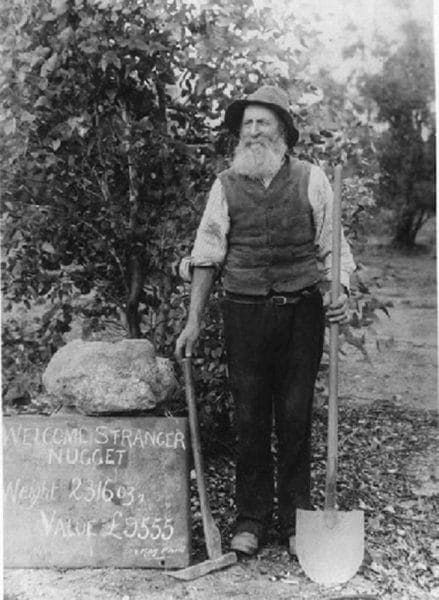
“The Welcome Stranger” is one of the largest gold nuggets found in Australia by prospectors John and Richard in one of the private mining mines. The weight of a piece of precious metal is almost 70 kilograms. The mass of the nugget was so large that there were no scales in the village to weigh it and determine the exact weight. A piece of ore was divided into several parts and sent to England. There it was melted down into the largest bar of gold and placed in a public bank in London.
Holtermann plate
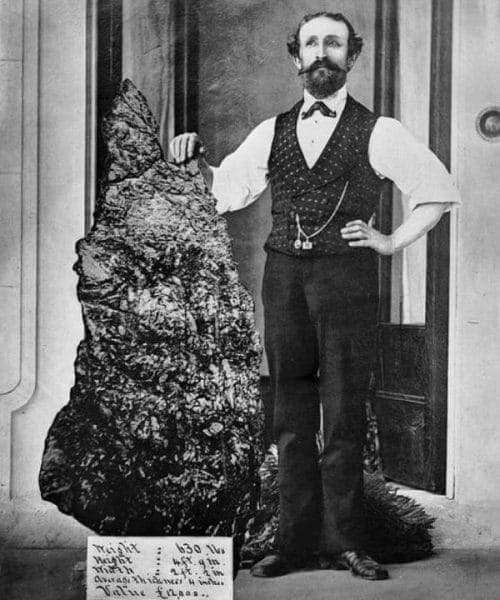
The “Holtermann Plate” is the largest gold nugget on the planet, which was extracted from the depths of the Earth in the fall of 1872. Gold miner Holterman and his colleague Hugo Beyens found a piece of gold weighing 235 kilograms. After melting the nugget, it turned out that it contained only 83 kilograms of pure gold ore. The rest of the piece consisted of quartz, iron and other impurities. However, despite this, the “Holterman Plate” is recognized as the largest gold nugget included in the Guinness Book of Records. Unfortunately, the piece of precious metal has not survived to this day. All information about him was obtained by scientists from entries in the personal diary of Hugo Beyens.
Myths and legends regarding nuggets
There is a legend in the world that may have some credibility. It says that the largest native gold in history was found in the mountains of Afghanistan. According to historians, the size of the nugget was described as “cubit by cubit”, which by modern standards would be about two tons.
There is another case without documentary evidence, which relates to Brazil. Allegedly, in the middle of the 19th century, a nugget weighing 193 kilograms was found here. And in the 16th century, a large gold nugget was taken from America, which sank along with a Spanish galleon, but there is no information about its size.
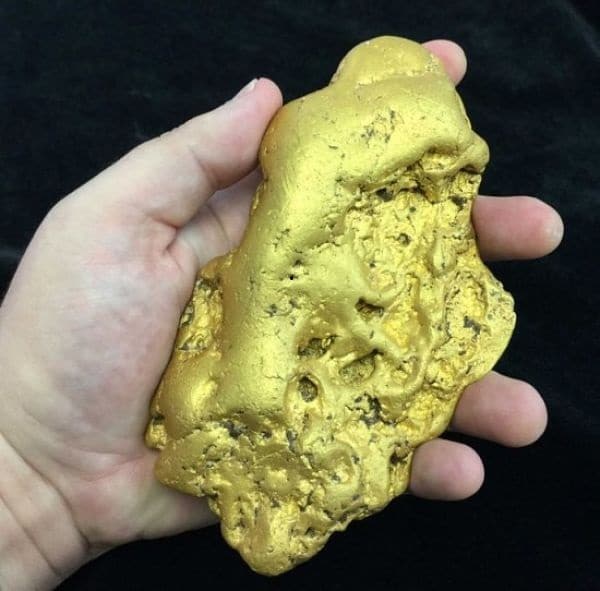
California prospector finds 6-pound gold nugget
Other gold nuggets, whose existence can neither be confirmed nor denied, are from the Czech Republic. The first of them allegedly weighed about two tons and was found in Bohemia in 1145, and the second, weighing slightly less than a ton, was found at the Eule mine in 725. Now scientists suggest that these were blocks of quartz rich in gold inclusions, or a cluster of smaller ones nuggets.

